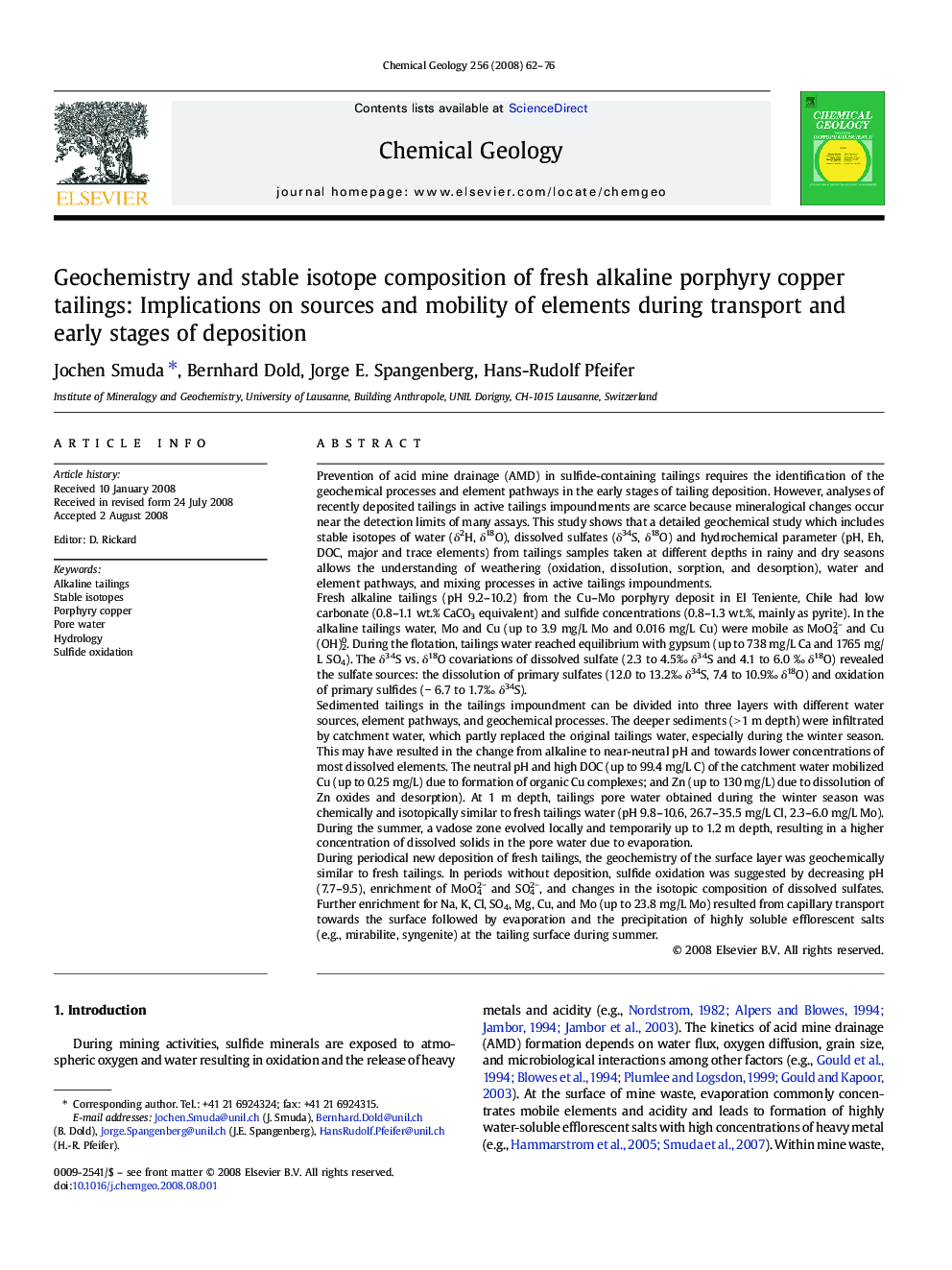| کد مقاله | کد نشریه | سال انتشار | مقاله انگلیسی | نسخه تمام متن |
|---|---|---|---|---|
| 4700461 | 1637720 | 2008 | 15 صفحه PDF | دانلود رایگان |

Prevention of acid mine drainage (AMD) in sulfide-containing tailings requires the identification of the geochemical processes and element pathways in the early stages of tailing deposition. However, analyses of recently deposited tailings in active tailings impoundments are scarce because mineralogical changes occur near the detection limits of many assays. This study shows that a detailed geochemical study which includes stable isotopes of water (δ2H, δ18O), dissolved sulfates (δ34S, δ18O) and hydrochemical parameter (pH, Eh, DOC, major and trace elements) from tailings samples taken at different depths in rainy and dry seasons allows the understanding of weathering (oxidation, dissolution, sorption, and desorption), water and element pathways, and mixing processes in active tailings impoundments.Fresh alkaline tailings (pH 9.2–10.2) from the Cu–Mo porphyry deposit in El Teniente, Chile had low carbonate (0.8–1.1 wt.% CaCO3 equivalent) and sulfide concentrations (0.8–1.3 wt.%, mainly as pyrite). In the alkaline tailings water, Mo and Cu (up to 3.9 mg/L Mo and 0.016 mg/L Cu) were mobile as MoO42− and Cu(OH)20. During the flotation, tailings water reached equilibrium with gypsum (up to 738 mg/L Ca and 1765 mg/L SO4). The δ34S vs. δ18O covariations of dissolved sulfate (2.3 to 4.5‰ δ34S and 4.1 to 6.0 ‰ δ18O) revealed the sulfate sources: the dissolution of primary sulfates (12.0 to 13.2‰ δ34S, 7.4 to 10.9‰ δ18O) and oxidation of primary sulfides (− 6.7 to 1.7‰ δ34S).Sedimented tailings in the tailings impoundment can be divided into three layers with different water sources, element pathways, and geochemical processes. The deeper sediments (> 1 m depth) were infiltrated by catchment water, which partly replaced the original tailings water, especially during the winter season. This may have resulted in the change from alkaline to near-neutral pH and towards lower concentrations of most dissolved elements. The neutral pH and high DOC (up to 99.4 mg/L C) of the catchment water mobilized Cu (up to 0.25 mg/L) due to formation of organic Cu complexes; and Zn (up to 130 mg/L) due to dissolution of Zn oxides and desorption). At 1 m depth, tailings pore water obtained during the winter season was chemically and isotopically similar to fresh tailings water (pH 9.8–10.6, 26.7–35.5 mg/L Cl, 2.3–6.0 mg/L Mo). During the summer, a vadose zone evolved locally and temporarily up to 1.2 m depth, resulting in a higher concentration of dissolved solids in the pore water due to evaporation.During periodical new deposition of fresh tailings, the geochemistry of the surface layer was geochemically similar to fresh tailings. In periods without deposition, sulfide oxidation was suggested by decreasing pH (7.7–9.5), enrichment of MoO42− and SO42−, and changes in the isotopic composition of dissolved sulfates. Further enrichment for Na, K, Cl, SO4, Mg, Cu, and Mo (up to 23.8 mg/L Mo) resulted from capillary transport towards the surface followed by evaporation and the precipitation of highly soluble efflorescent salts (e.g., mirabilite, syngenite) at the tailing surface during summer.
Journal: Chemical Geology - Volume 256, Issues 1–2, 30 October 2008, Pages 62–76